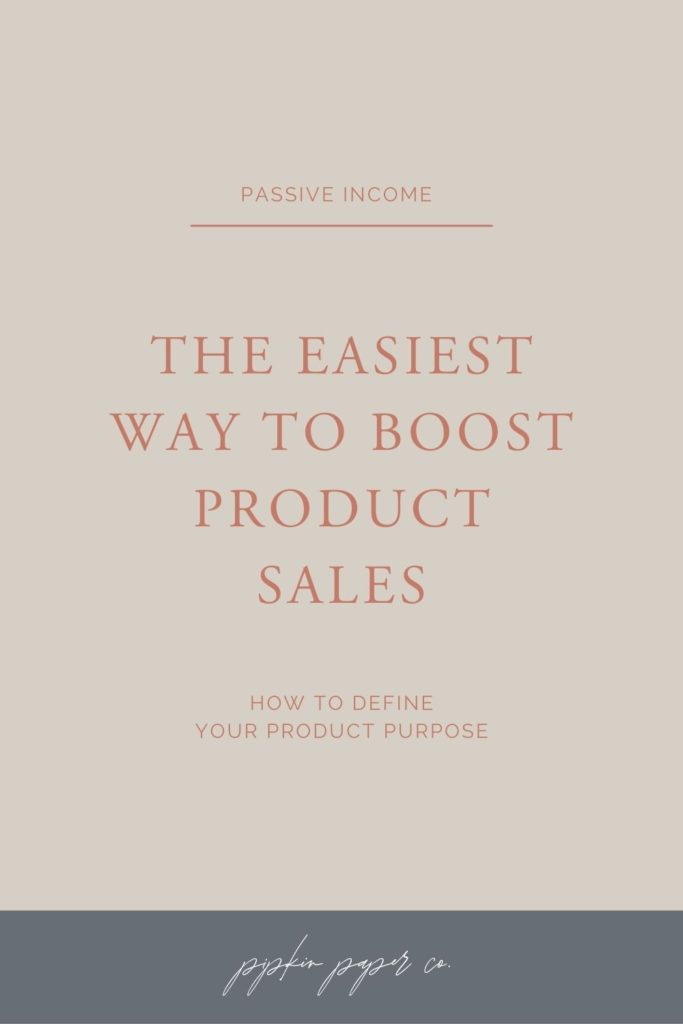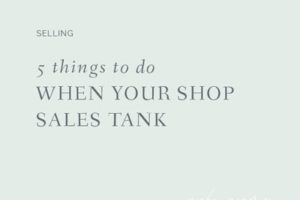The Easiest Way to Boost Sales? Define Your Product Purpose
Nine out of ten times, when I talk to digital product creators who have great looking products but are making sad, lackluster sales, it’s because of one thing:
They haven’t clearly defined their product purpose (or at least not one they’ve articulated to the customer).
It really doesn’t matter what you’re selling – website templates, ebooks, printables – people aren’t going to pull out their credit cards if they’re confused about what you’re selling and who it’s made for.
Customers won’t buy products they don’t understand.
It’s as simple as that.
So if you want to boost your sales without have to create new products, you’ll need to define your product purpose.
Here’s how to do that.

How to Define Your Product Purpose
What your customers really want to know is, Will this help me? And how? Once you tell them that, everything else becomes easy.
The best time to define your product purpose is before you’ve actually created anything.
That way you can tailor your product design to meet your customers’ needs.
But if you didn’t come up with a purpose ahead of time, that’s ok. It’s never too late create a purpose statement you can add to product listings or sales pages. Even one made after the fact will still give buyers clarity so they’re not nearly afraid to hit the buy now button.
One | WHO: Figure out who you serve
I know you’ve heard this before, but you need to know who you serve.
If you’re worried about limiting yourself or cutting off your sales, defining your customer doesn’t mean you can’t sell your product to other people as well. But in order to speak directly to your customer, you need to know who you customer is.
Think about who you can help achieve the best results or who you’ve helped in the past to achieve the best results.
The more specific the better!
Questions:
• Who do you serve?
• Who would you enjoy working with and helping?
Two | WHAT: Identify the transformation
A product purpose is like an elevator pitch for the product.
It’s a few sentences that explain what the product is, who it’s for and what outcome it gives to the customer.
Remember, the value of a digital product isn’t about how much content you can cram into it. It’s about the transformation.
So before we can flesh out the purpose statement, we need to know what your product actually does for the customer. What transformation does it lead them through? How does it make their lives easier? What’s the starting point, end point, and all the action in between?
This is what you’re actually selling.
Questions:
• What’s your customer’s biggest problem?
• At what point do they feel like throwing in the towel and looking for outside help (you or your product)?
• What are they trying solve by buying your product?
• Where is the customer trying to go? What does the solution look like?
• What journey does your product facilitate?
If you can pinpoint the exact moment when someone starts searching for your product, you can connect with them on an entirely different level and in a way that your competition can’t.
Three | HOW: Define the game plan
You can’t just tell people that you get big results. You need to tell them how you do it so they’ll know if your product is a good fit for them.
Good: “I help business owners book out their services 6 months in advance with the help of a step-by-step social media marketing plan that sells.”
Bad: “I help customers create their first e-course.”
See the difference? One helps customers determine if the product is a good fit for their needs by spelling out how the product helps and what’s actually involved in the transformation. The other just gives customers another item to check off their to do list.
Question:
• How do you help customers achieve the transformation?
Four | WHY: Consider why this matters
Once the customer has completed your course, read your ebook, or used your product, what becomes possible for the them? Why is the change important?
This is more of an existential why. You want to show the customer how their life will change in the long run after using your product and not someone else’s.
Questions:
• Why should the customer want to achieve this transformation?
• Why does it matter?
• What doors open up once they make a big change?
Five | PUT IT ALL TOGETHER
Now that you’ve done all the digging, it’s time to actually define your product purpose and put everything into a single, cohesive statement.
I help [WHO] achieve [WHAT] by [HOW], so that they can [WHY].
This is what sets your product apart from all the other products out there and helps customers know immediately if your product is right for there.
You want to put this purpose statement on your sales page, item description, shop homepage or wherever else customers make purchasing decisions.
Your purpose statement doesn’t have to be a big, complex thing. As you’re thinking about getting your customer from Point A to Point B, simple is better. More than likely, they’re frustrated and just want to know that their problem will be solved – hopefully, with the help of your product. But if not, that’s okay, too. The goal isn’t always to land the sale, sometimes weeding out customers who aren’t a good fit is equally important.
Next Up: How to Not Get Sued in Your Digital Product Business
The information contained on this Website and the resources available for download through this website are for educational and informational purposes only. I am only sharing what worked for me, and as such, I cannot guarantee that any products or processes will give you the same results.





Leave a Reply
We don't like getting spam either. Your email is safe with us.